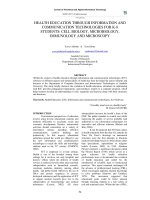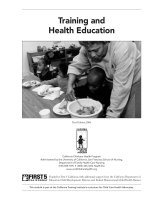EVIDENCE-BASED PARTICIPATORY HEALTH EDUCATION GUIDELINES potx
Bạn đang xem bản rút gọn của tài liệu. Xem và tải ngay bản đầy đủ của tài liệu tại đây (95.16 KB, 4 trang )
1
INTERNATIONAL & NATIONAL STANDARDS & PRACTICE GUIDELINES
WHO=World Health Organization & its divisions & collaborating partners.
HHS=Dept of Health & Human Services & its divisions & collaborating partners.
EVIDENCE-BASED PARTICIPATORY
HEALTH EDUCATION GUIDELINES
BACKGROUND: The importance of evidence-based health education has been emphasized
by numerous international and national guidelines. For example, the World Health Report 2008
emphasizes the following as one of the most important problems in both developed and
developing countries world-wide:
"Misdirected care. Resource allocation clusters around curative services at great cost, neglecting
the potential of primary prevention and health promotion to prevent up to 70% of the
disease burden"
See the above report and the following for further documentation and examples: Saving the
Most Lives and Preventing the Most Suffering-Why is Evidence-Based Health Education so
Critically Important?
The importance of the participatory approach for teaching all age groups, at all levels of the
health care pyramid, has also been emphasized by numerous international and national
guidelines (See, for example, Best Practices in Global health Missions' Health Education links).
The participatory approach is therefore utilized by both long-term and short-term missions.
It is used by Community Health/Primary Care Medical Teams (Focus on demonstrating
to local providers how to Integrate Community Health into Primary Care Practice See How the
Program has Been Used By Community Health/Primary Care Medical Teams).
It is also used by Health Screening Medical Teams (Focus on primary prevention and
health promotion and the Community's Most Important Healthcare Problems See How the
Program has been used by Health Screening Medical Teams
For example, for Health Screening events, the participatory process usually begins with
distribution of the advertising flyers and continues onsite as patients are waiting in line to
register. Using "The 3 Things" approach, the Flyers lead people to ask "What are these 3 things
that WE can do that would prevent 80% of heart disease, 80% of stroke, etc?" As patients are
waiting in line to register, a health educator can use the 11x17 posters to draw out the answers
from the people. The lesson (with the WHO answers) is also included in the Patient Health
Screening and Education Record which is given to the patient for further reinforcement and
multiplication of the lesson to the patient's family and friends.
GUIDELINES: The following apply to both "Community Health/Primary Care" and
"Health Screening," Long-term and Short-term, Medical Teams.
1. Team & Local Health Educators: Although WHO and HHS guidelines are lifesaving, some
are relatively complex and take time to properly demonstrate. And the participatory approach,
HEALTH EDUCATION PROGRAM
FOR
DEVELOPING COUNTRIES
(THE MOST IMPORTANT KNOWLEDGE)
ENGLISH / FRENCH
KHMER / MANDARIN
SPANISH
www.hepfdc.info
DOWNLOAD
FREE
2
although definitely most effective, is also time-consuming; and providers rarely have adequate
time. Health Educators are therefore required for both group health education, and for provider
referrals for individual patient counseling.
Referral to Team and Local Health Educators enables team and clinic compliance with
international and national standards of care. There is no position more important in meeting
these requirements for our patients' health and wellbeing. This is true at all levels of the
healthcare pyramid: Hospital, Clinic/health-center, or Family/Community (Includes Church &
School).
For STMs, most Health Educators are nurses with training/experience in patient teaching; or
teachers with training/experience/ in teaching health. Most are volunteers from the team and
from local in-country sponsoring churches, schools and clinics.
Team & Local Health Educators work together as teams. Local Health Educators often have
not had training in the program content, or in the participatory approach; so the Team Health
Educator's expertise and example are very important. Also, as US healthcare providers are
nearly always very highly respected by patients from developing countries, this process strongly
supports and reinforces the MOH and local community physicians, nurses, teachers, pastors and
other educators in their attempts to implement WHO guidelines after we leave.
However, the Local Health Educator knows the culture, and this is critically important in
presenting the information in the most effective manner for beneficial change/transformation.
The Local Health Educator is also essential for ensuring the sustainability and multiplication of
the team's efforts.
The number of Health Educators required will depend on the size of the team and number of
patients to be evaluated At least two are needed to provide health education to groups of
patients waiting to be seen. Others are needed to provide individual health counseling to patients
referred by team/local physicians for conditions requiring time-consuming counseling. Others
may be needed to man Health Fair or other booths for additional participatory learning. Usually
the Health Educators alternate positions.
2. Evidence-based Health Education Materials from international and national standards and
guidelines (See Evidence-based Community Health Screening and Education Guidelines):
a. For Community Health/Primary Care Medical Teams: The Health Education Program
For Developing Countries is available free for downloading, and is distributed to all team
providers and health educators.
The local version will be in the local community’s language (Spanish/ Mandarin/ French/
Khmer) and is also available free for downloading. This is important for sustainability, as well
as multiplication of teaching efforts to surrounding communities after we leave.
Local educators soon have much of the information memorized and use the Handbook and
Illustrations to teach others, utilizing the cultural and participatory approach that is most
effective for their particular community.
b. For Community Health Screening & Education(CHS&E) Medical Teams: As CHS&E
teams focus on specific areas pre-selected by the community to address their most important
healthcare problems, there is usually no need to utilize the entire the Health Education Program
For Developing Countries program.
A copy of the relevant written Handbook and Illustration sections of the program are
therefore incorporated into a Patient Education/Counseling Folder (See Section IV on the
HEPFDC Health Screening page.)
3
This Patient Education/Counseling Folder is available free for downloading, and is
distributed to all team providers and health educators. (It is also incorporated into the Provider
Guidelines & Patient Counseling Folder)
To enable sustainability, as well as multiplication of teaching efforts to surrounding
communities after we leave, additional copies in all languages may be downloaded free from
Section IV on the HEPFDC Health Screening page.
3. Poster-size illustrations and large screen projections. Health Educators use these to
discuss the most critical community-specific health problems with groups of patients. This often
occurs as patients are waiting to be evaluated by healthcare providers This is wonderful
teaching opportunity that is often missed. It is especially helpful when waiting times are long.
(Also, when all arrivals cannot be evaluated, they may be referred for follow up health education
services provided by the local clinic, school or church educators after we leave.)
Note concerning formats: All Health Education Program For Developing Countries
illustrations are in the PDF format which can be downloaded free and shown directly on
computer monitors, or on large screen projectors, or printed in the 8.5x11 inch Letter-size.
The 8.5x11 illustrations are used in Notebook, Binder and Folder format for individual and
family counseling.
11x17 inch Tabloid-size for posters for teaching groups: The 8.5x11 Letter-size PDF files
may be easily enlarged (129%) to the 11x17 Tabloid-size either on your computer, or by
providing the PDF file to your local copy or office supply shop. 11x17 inch Tabloid-size
posters (two illustrations placed back to back, 5 mil laminated) are usually available for $5-$6.
See: Producing Your Own Notebooks and Posters
4. Group participatory presentation topics. Medical Directors assign sections of the Health
Education Program For Developing Countries for group presentation based upon the
community’s most critical health care needs.
All of the following lessons can be obtained from the HEPFDC DOWNLOAD FREE page at
www.hepfdc.info. The material covered by each health educator at each station for "groups of
patients" should be part of a coordinated approach to prevent duplication, and to ensure "the
most important knowledge" is made available to as many patients as possible.
For Community Health Screening & Education "The 3 Things" approach, Sections 38 and 41
are emphasized. Usually this is all that time permits.
Other missions may focus on the following as determined by the local community and MOH:
a. Topics most often requested for presentation to groups of patients include:
Sections 1-11(Includes the common causes of death in the developing world. Also introduces
holistic health care) Additional frequently requested topics include:
-Respiratory Infections (Sections 29, 30A&B)
-HIV/AIDS (Sections 4 & 5)
-Accident Prevention (Sections 44, 45, 46, 47 & 48)
-Safe Food Preparation (Section 17A&B)
-Recovering from Disasters & Other Traumatic Events (Section 49)
as well as those listed under the following:
b. Topics most often requested from physician referrals for additional individual counseling
vary depending on the location, however, because of limited physician time, conditions such as
the following will nearly always require referral to the Health Educator:
-CDC/WHO Lifesaving Guidelines for Treatment of Diarrhea (Sections 22-27)
4
-Problems with Breastfeeding (often a death sentence in developing counties) (Section 20)
-Heart disease, Stroke, Type 2 Diabetes (Sections 38 & 41)
5. Additional participatory approaches and materials The "Just One Soda" and others most
commonly used in health screening and health fair settings are also available free on the
HEPFDC Participatory Approaches page at www.hepfdc.info
6. Lesson Plan and Picture Book versions of the Health Education Program For Developing
Countries were specifically developed to assist Community Health Educators(CHEs) in
implementing the participatory approach. These are also used for children and illiterate
populations. These versions of the program can also be downloaded free at: CHE Lesson Plans
and Picture Books (We are deeply indebted to Jody Collinge, MD, FAAP, and the Global CHE
Network for these excellent resources.)
7. Health Educator Consultant. A qualified physician will be appointed to serve as consultant
for those questions the Health Educator is unable to answer. In practice, most potential questions
are addressed in the Handbook, and additional consultation is seldom needed.
(Please also refer any important questions that are not addressed in the program to
for incorporation into future updates.)
Updated 7/22/2011 HEPFDC Down Load Free at www.hepfdc.info









